Infection Control and Prevention Measures
VerifiedAdded on 2020/03/16
|15
|4041
|478
Report
AI Summary
This report discusses infection control and prevention measures in healthcare settings, focusing on risk assessments, hospital design, and the use of appropriate disinfectants. It highlights the importance of educating medical staff on handling sharp tools and maintaining proper ventilation to prevent the spread of airborne diseases. The report concludes with recommendations for effective control measures to enhance safety in hospitals.
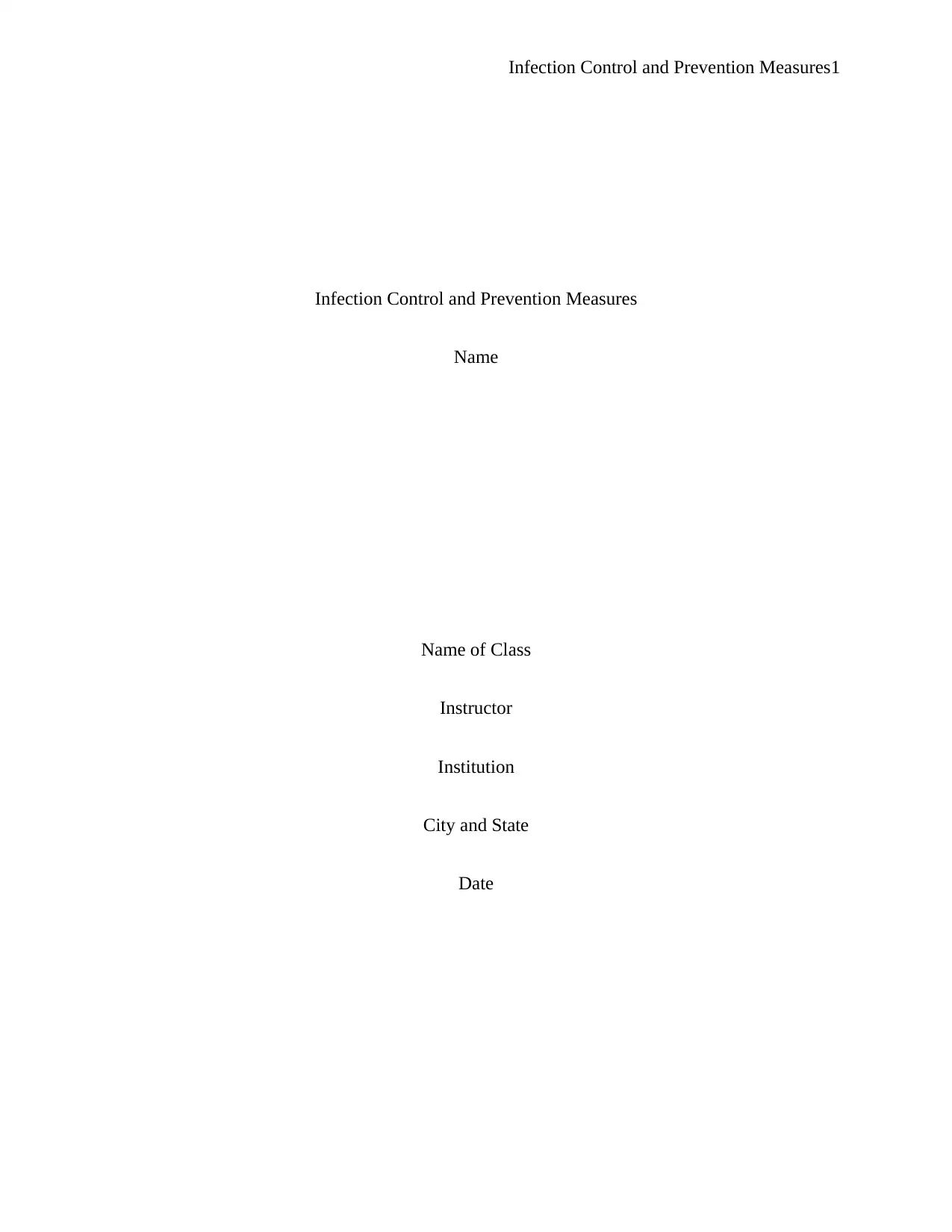
Infection Control and Prevention Measures1
Infection Control and Prevention Measures
Name
Name of Class
Instructor
Institution
City and State
Date
Infection Control and Prevention Measures
Name
Name of Class
Instructor
Institution
City and State
Date
Paraphrase This Document
Need a fresh take? Get an instant paraphrase of this document with our AI Paraphraser
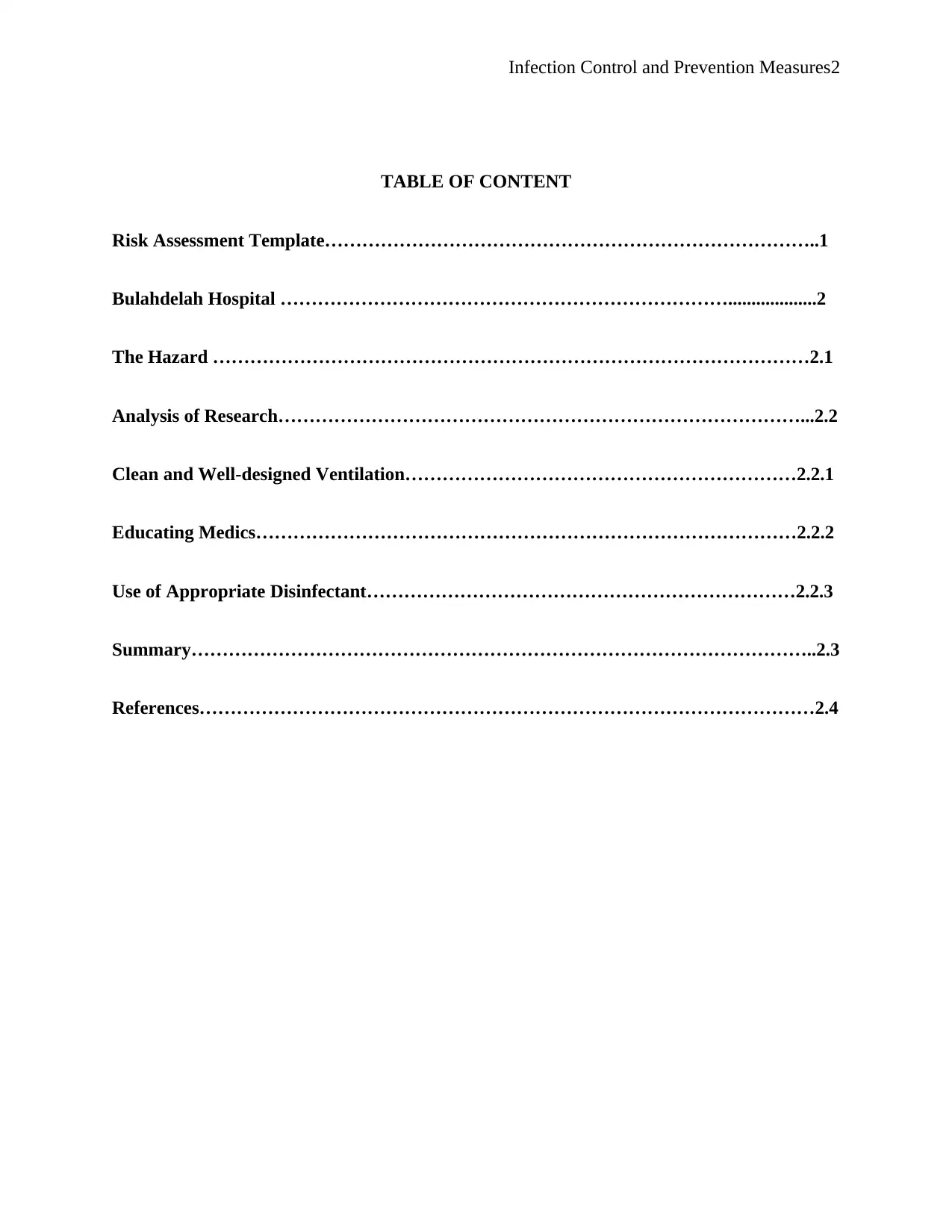
Infection Control and Prevention Measures2
TABLE OF CONTENT
Risk Assessment Template……………………………………………………………………..1
Bulahdelah Hospital ………………………………………………………………...................2
The Hazard ……………………………………………………………………………………2.1
Analysis of Research…………………………………………………………………………...2.2
Clean and Well-designed Ventilation………………………………………………………2.2.1
Educating Medics……………………………………………………………………………2.2.2
Use of Appropriate Disinfectant……………………………………………………………2.2.3
Summary………………………………………………………………………………………..2.3
References………………………………………………………………………………………2.4
TABLE OF CONTENT
Risk Assessment Template……………………………………………………………………..1
Bulahdelah Hospital ………………………………………………………………...................2
The Hazard ……………………………………………………………………………………2.1
Analysis of Research…………………………………………………………………………...2.2
Clean and Well-designed Ventilation………………………………………………………2.2.1
Educating Medics……………………………………………………………………………2.2.2
Use of Appropriate Disinfectant……………………………………………………………2.2.3
Summary………………………………………………………………………………………..2.3
References………………………………………………………………………………………2.4
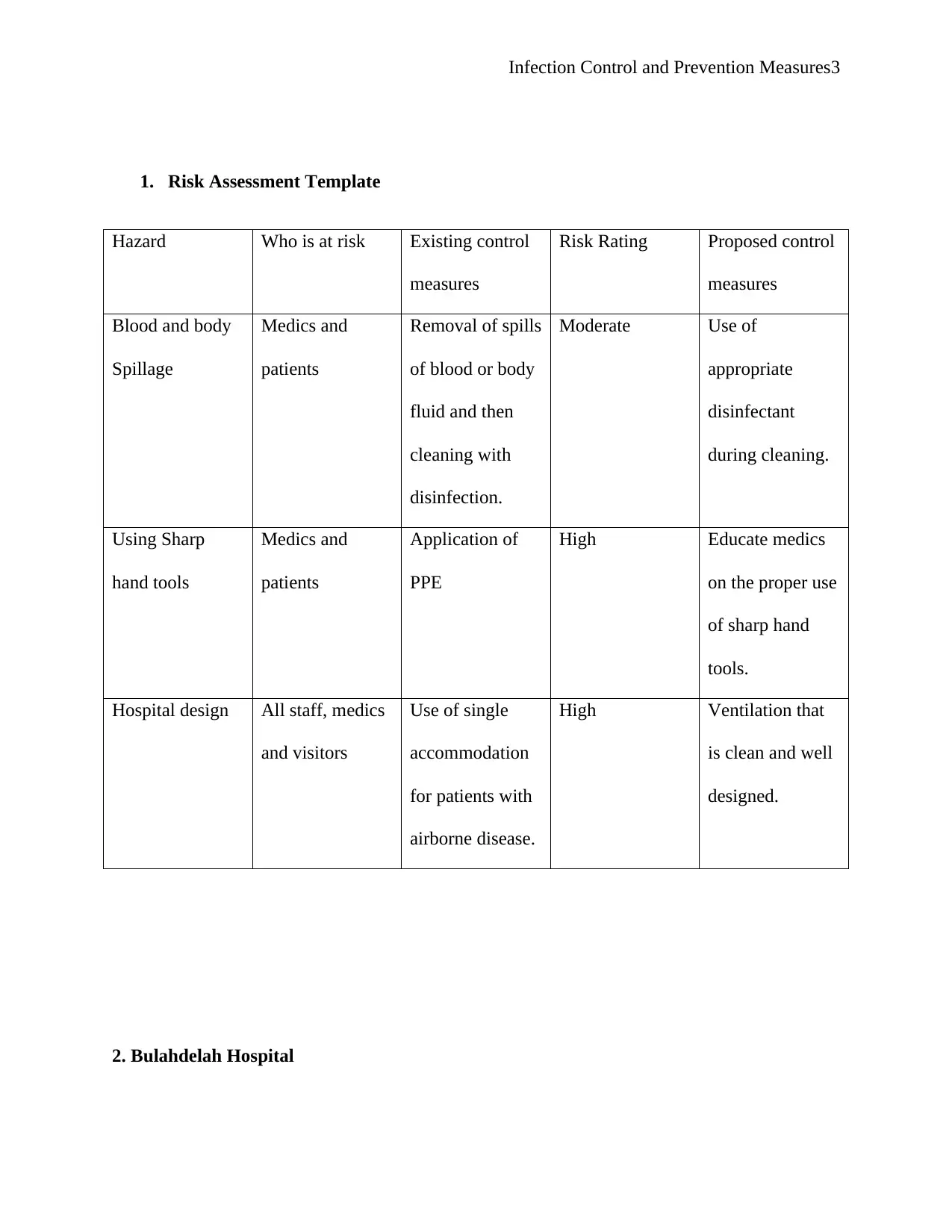
Infection Control and Prevention Measures3
1. Risk Assessment Template
Hazard Who is at risk Existing control
measures
Risk Rating Proposed control
measures
Blood and body
Spillage
Medics and
patients
Removal of spills
of blood or body
fluid and then
cleaning with
disinfection.
Moderate Use of
appropriate
disinfectant
during cleaning.
Using Sharp
hand tools
Medics and
patients
Application of
PPE
High Educate medics
on the proper use
of sharp hand
tools.
Hospital design All staff, medics
and visitors
Use of single
accommodation
for patients with
airborne disease.
High Ventilation that
is clean and well
designed.
2. Bulahdelah Hospital
1. Risk Assessment Template
Hazard Who is at risk Existing control
measures
Risk Rating Proposed control
measures
Blood and body
Spillage
Medics and
patients
Removal of spills
of blood or body
fluid and then
cleaning with
disinfection.
Moderate Use of
appropriate
disinfectant
during cleaning.
Using Sharp
hand tools
Medics and
patients
Application of
PPE
High Educate medics
on the proper use
of sharp hand
tools.
Hospital design All staff, medics
and visitors
Use of single
accommodation
for patients with
airborne disease.
High Ventilation that
is clean and well
designed.
2. Bulahdelah Hospital
⊘ This is a preview!⊘
Do you want full access?
Subscribe today to unlock all pages.

Trusted by 1+ million students worldwide
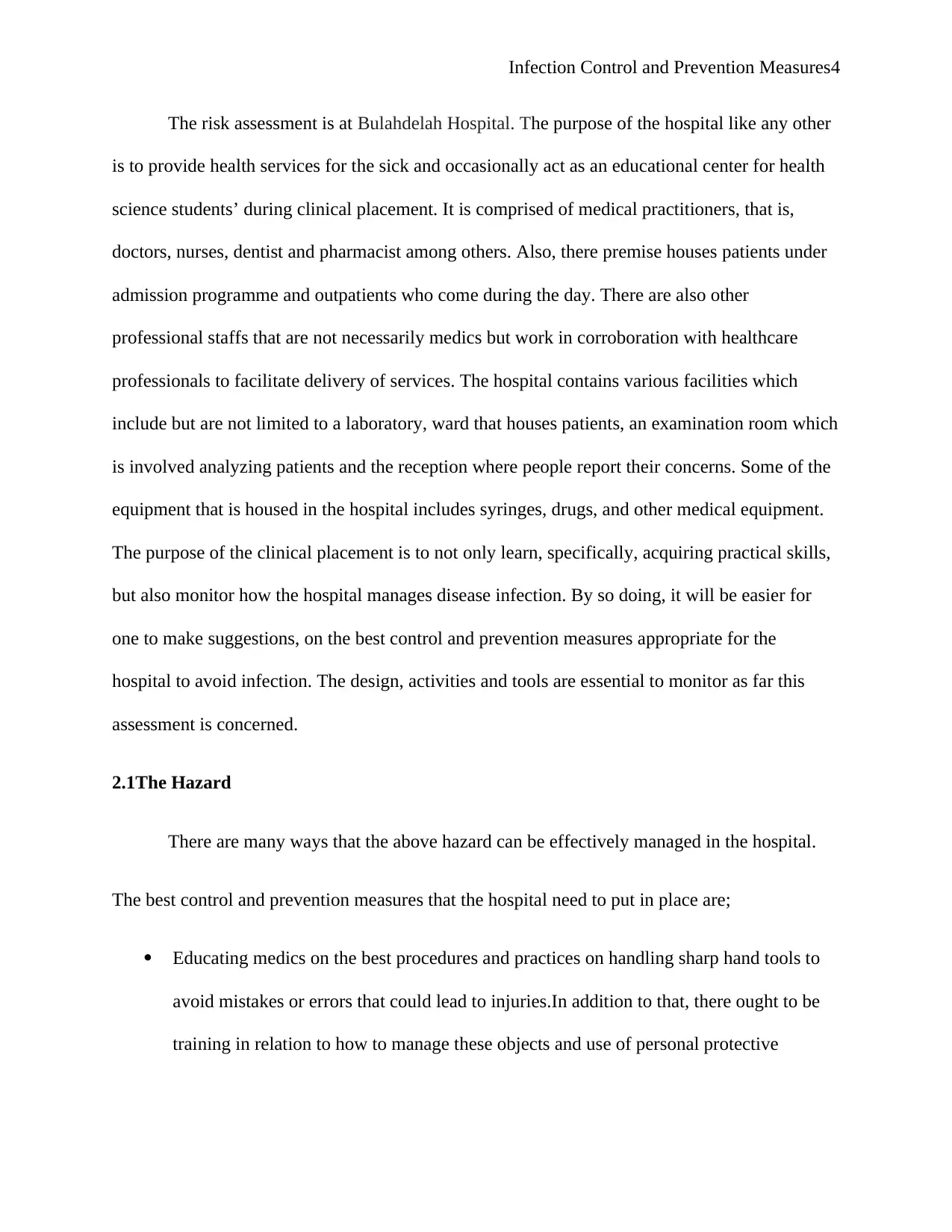
Infection Control and Prevention Measures4
The risk assessment is at Bulahdelah Hospital. The purpose of the hospital like any other
is to provide health services for the sick and occasionally act as an educational center for health
science students’ during clinical placement. It is comprised of medical practitioners, that is,
doctors, nurses, dentist and pharmacist among others. Also, there premise houses patients under
admission programme and outpatients who come during the day. There are also other
professional staffs that are not necessarily medics but work in corroboration with healthcare
professionals to facilitate delivery of services. The hospital contains various facilities which
include but are not limited to a laboratory, ward that houses patients, an examination room which
is involved analyzing patients and the reception where people report their concerns. Some of the
equipment that is housed in the hospital includes syringes, drugs, and other medical equipment.
The purpose of the clinical placement is to not only learn, specifically, acquiring practical skills,
but also monitor how the hospital manages disease infection. By so doing, it will be easier for
one to make suggestions, on the best control and prevention measures appropriate for the
hospital to avoid infection. The design, activities and tools are essential to monitor as far this
assessment is concerned.
2.1The Hazard
There are many ways that the above hazard can be effectively managed in the hospital.
The best control and prevention measures that the hospital need to put in place are;
Educating medics on the best procedures and practices on handling sharp hand tools to
avoid mistakes or errors that could lead to injuries.In addition to that, there ought to be
training in relation to how to manage these objects and use of personal protective
The risk assessment is at Bulahdelah Hospital. The purpose of the hospital like any other
is to provide health services for the sick and occasionally act as an educational center for health
science students’ during clinical placement. It is comprised of medical practitioners, that is,
doctors, nurses, dentist and pharmacist among others. Also, there premise houses patients under
admission programme and outpatients who come during the day. There are also other
professional staffs that are not necessarily medics but work in corroboration with healthcare
professionals to facilitate delivery of services. The hospital contains various facilities which
include but are not limited to a laboratory, ward that houses patients, an examination room which
is involved analyzing patients and the reception where people report their concerns. Some of the
equipment that is housed in the hospital includes syringes, drugs, and other medical equipment.
The purpose of the clinical placement is to not only learn, specifically, acquiring practical skills,
but also monitor how the hospital manages disease infection. By so doing, it will be easier for
one to make suggestions, on the best control and prevention measures appropriate for the
hospital to avoid infection. The design, activities and tools are essential to monitor as far this
assessment is concerned.
2.1The Hazard
There are many ways that the above hazard can be effectively managed in the hospital.
The best control and prevention measures that the hospital need to put in place are;
Educating medics on the best procedures and practices on handling sharp hand tools to
avoid mistakes or errors that could lead to injuries.In addition to that, there ought to be
training in relation to how to manage these objects and use of personal protective
Paraphrase This Document
Need a fresh take? Get an instant paraphrase of this document with our AI Paraphraser

Infection Control and Prevention Measures5
equipment (Dancer, 2014). Lastly, the education must involve risks of transmission of
the pathogens associated with using sharp objects.
On the other hand, there is the hospital design that has the potential to cause transmission
of airborne diseases, such as tuberculosis. This ought to be well maintained in the sense
that change rate is well achieved and sustained. The reason is that poorly maintained
ventilation has the potential to act as a source of airborne infection.
Lastly, blood and body spillage are other hazards in hospital. The best method of
cleaning is to choose an appropriate disinfectant for cleaning.
The impacts of the hazard are numerous. These include but are not limited to;
Blood and body spillage have the potential to cause injuries or spread diseases of a
patient.
On the other hand, hospital design may lead to the spread of airborne diseases such as
tuberculosis from one patient to another, or from patients to staff.
Lastly, sharp tools may damage the eye or cause cuts which act as an entry point of
pathogens and viruses.
In Bulahdelah Hospital, there are various ways that the three hazards are controlled. Specifically,
The hospital has set out a single isolation room to cater for patients with airborne
diseases.
Another control and prevention measure is that the hospital has laid out a clear procedure
to be followed by nurses in cleaning and applying disinfectants on spots where blood and
spillage have occurred.
Lastly, there is the PPE that medics follow in handling sharp hand tools and objects.
equipment (Dancer, 2014). Lastly, the education must involve risks of transmission of
the pathogens associated with using sharp objects.
On the other hand, there is the hospital design that has the potential to cause transmission
of airborne diseases, such as tuberculosis. This ought to be well maintained in the sense
that change rate is well achieved and sustained. The reason is that poorly maintained
ventilation has the potential to act as a source of airborne infection.
Lastly, blood and body spillage are other hazards in hospital. The best method of
cleaning is to choose an appropriate disinfectant for cleaning.
The impacts of the hazard are numerous. These include but are not limited to;
Blood and body spillage have the potential to cause injuries or spread diseases of a
patient.
On the other hand, hospital design may lead to the spread of airborne diseases such as
tuberculosis from one patient to another, or from patients to staff.
Lastly, sharp tools may damage the eye or cause cuts which act as an entry point of
pathogens and viruses.
In Bulahdelah Hospital, there are various ways that the three hazards are controlled. Specifically,
The hospital has set out a single isolation room to cater for patients with airborne
diseases.
Another control and prevention measure is that the hospital has laid out a clear procedure
to be followed by nurses in cleaning and applying disinfectants on spots where blood and
spillage have occurred.
Lastly, there is the PPE that medics follow in handling sharp hand tools and objects.

Infection Control and Prevention Measures6
In implementing control and prevention measures in the hospital, there is a committee of
safety that lay out procedures for medics to follow during the implementation of the control
and prevention measures.
2.2 Analysis of Research
2.2.1Clean and well-designed Ventilation
Proper ventilation is an important way of preventing the spread of airborne diseases in the
hospital. Research indicates that single room accommodation that the hospital use cannot contain
is not effective in the prevention of airborne diseases for some reasons. Firstly, this measure is
often compromised by lack of proper of hygiene (Damuth et al., 2015). In addition to that, the
staff tends to fix the room where the isolated patient is located with the door wide open so that
she or he can be in a position to monitor the patient at all times. In addition to that, statistics
show that not all hospital can provide patients suffering from those diseases with single room
accommodation (Chartier, 2014). However, in hospital, the major reason for ventilation is to
offer healthy air for breathing by diluting the contaminated air that is originating from the room,
thus, supplying a clean and fresh air from outside the room. Therefore, to monitor airborne
diseases, research conducted in 2014, suggest that there is need to consider the quality and
amount of air that comes from outside, that is, the ventilation rate (Mehta et al., 2014). In
addition to that, there is need to determine the airflow direction and the ideal being that, that
which flow from clean zones to the dirty zones. Lastly, the study recommends that distribution of
air is important in that, it must be to each part and corner of the room or ward that houses the
patients (Klompas et al., 2014). This, according to the study, will make it possible to remove
contaminated air but at the same time bring in clean air. This study thus, speaks of the two
In implementing control and prevention measures in the hospital, there is a committee of
safety that lay out procedures for medics to follow during the implementation of the control
and prevention measures.
2.2 Analysis of Research
2.2.1Clean and well-designed Ventilation
Proper ventilation is an important way of preventing the spread of airborne diseases in the
hospital. Research indicates that single room accommodation that the hospital use cannot contain
is not effective in the prevention of airborne diseases for some reasons. Firstly, this measure is
often compromised by lack of proper of hygiene (Damuth et al., 2015). In addition to that, the
staff tends to fix the room where the isolated patient is located with the door wide open so that
she or he can be in a position to monitor the patient at all times. In addition to that, statistics
show that not all hospital can provide patients suffering from those diseases with single room
accommodation (Chartier, 2014). However, in hospital, the major reason for ventilation is to
offer healthy air for breathing by diluting the contaminated air that is originating from the room,
thus, supplying a clean and fresh air from outside the room. Therefore, to monitor airborne
diseases, research conducted in 2014, suggest that there is need to consider the quality and
amount of air that comes from outside, that is, the ventilation rate (Mehta et al., 2014). In
addition to that, there is need to determine the airflow direction and the ideal being that, that
which flow from clean zones to the dirty zones. Lastly, the study recommends that distribution of
air is important in that, it must be to each part and corner of the room or ward that houses the
patients (Klompas et al., 2014). This, according to the study, will make it possible to remove
contaminated air but at the same time bring in clean air. This study thus, speaks of the two
⊘ This is a preview!⊘
Do you want full access?
Subscribe today to unlock all pages.

Trusted by 1+ million students worldwide
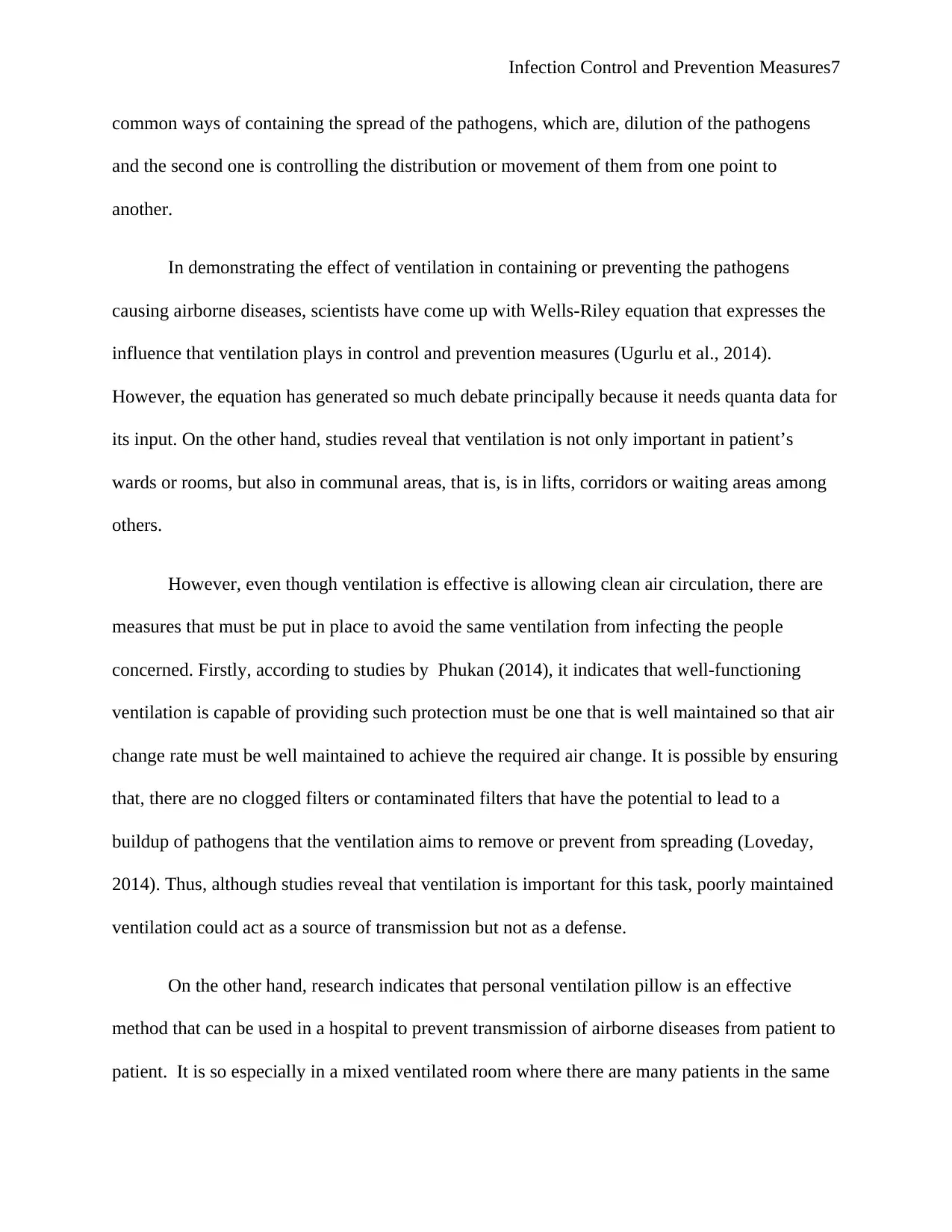
Infection Control and Prevention Measures7
common ways of containing the spread of the pathogens, which are, dilution of the pathogens
and the second one is controlling the distribution or movement of them from one point to
another.
In demonstrating the effect of ventilation in containing or preventing the pathogens
causing airborne diseases, scientists have come up with Wells-Riley equation that expresses the
influence that ventilation plays in control and prevention measures (Ugurlu et al., 2014).
However, the equation has generated so much debate principally because it needs quanta data for
its input. On the other hand, studies reveal that ventilation is not only important in patient’s
wards or rooms, but also in communal areas, that is, is in lifts, corridors or waiting areas among
others.
However, even though ventilation is effective is allowing clean air circulation, there are
measures that must be put in place to avoid the same ventilation from infecting the people
concerned. Firstly, according to studies by Phukan (2014), it indicates that well-functioning
ventilation is capable of providing such protection must be one that is well maintained so that air
change rate must be well maintained to achieve the required air change. It is possible by ensuring
that, there are no clogged filters or contaminated filters that have the potential to lead to a
buildup of pathogens that the ventilation aims to remove or prevent from spreading (Loveday,
2014). Thus, although studies reveal that ventilation is important for this task, poorly maintained
ventilation could act as a source of transmission but not as a defense.
On the other hand, research indicates that personal ventilation pillow is an effective
method that can be used in a hospital to prevent transmission of airborne diseases from patient to
patient. It is so especially in a mixed ventilated room where there are many patients in the same
common ways of containing the spread of the pathogens, which are, dilution of the pathogens
and the second one is controlling the distribution or movement of them from one point to
another.
In demonstrating the effect of ventilation in containing or preventing the pathogens
causing airborne diseases, scientists have come up with Wells-Riley equation that expresses the
influence that ventilation plays in control and prevention measures (Ugurlu et al., 2014).
However, the equation has generated so much debate principally because it needs quanta data for
its input. On the other hand, studies reveal that ventilation is not only important in patient’s
wards or rooms, but also in communal areas, that is, is in lifts, corridors or waiting areas among
others.
However, even though ventilation is effective is allowing clean air circulation, there are
measures that must be put in place to avoid the same ventilation from infecting the people
concerned. Firstly, according to studies by Phukan (2014), it indicates that well-functioning
ventilation is capable of providing such protection must be one that is well maintained so that air
change rate must be well maintained to achieve the required air change. It is possible by ensuring
that, there are no clogged filters or contaminated filters that have the potential to lead to a
buildup of pathogens that the ventilation aims to remove or prevent from spreading (Loveday,
2014). Thus, although studies reveal that ventilation is important for this task, poorly maintained
ventilation could act as a source of transmission but not as a defense.
On the other hand, research indicates that personal ventilation pillow is an effective
method that can be used in a hospital to prevent transmission of airborne diseases from patient to
patient. It is so especially in a mixed ventilated room where there are many patients in the same
Paraphrase This Document
Need a fresh take? Get an instant paraphrase of this document with our AI Paraphraser

Infection Control and Prevention Measures8
room (Knape, 2015). According to the study, its effectiveness is at 98 percent and prevents
infection at mouth level either when patients are lying on their back or sideways. However, the
study documents that this is only possible in a single ventilated room but cannot be applicable in
a mixed ventilated room. The best method in such cases, according to the study, is to provide
personal ventilated pillow to only the person with the infectious disease. The same study
documents that the method is also effective, though at 91 percent to reduce the possibility of
airborne disease transmission at the receiver patient during continuous movements of patients in
hospital (Hobday, & Dancer, 2013). Therefore, these are enough reasons that the hospital needs
to apply this method for control and prevention of airborne diseases.
2.2.2 Educating Medics
There are many reasons that one can advocate for educating medics on hand tools. In
hospitals, there are many incidences of disease transmission from sharp hand tools that medics
use. Ina research conducted in 2011, there were indications that most professionals either ignore
or do not follow the guidelines completely laid out in the procedural manure on the effective use
and handling of sharp hand objects (Beggs et al., 2015). Firstly, studies indicate that of all
workers that experienced injuries, about sixteen percent represent those who did not put on
gloves when the incident was taking place (Cao et al., 2014). On the other hand, fifty-five of the
cases involved malpractices when using the equipment. Another study stipulates that about
twenty-four percent represents injuries as a result of needle recapping while sixteen percent was
a result of the careless disposal of sharp objects ( Zingg et al., 2015). Thus, the study reveals that
even though there is a general assumption that medics are well knowledgeable in matters of
handling hand tools in healthcare, studies reveal otherwise, in that, practitioners have shallow
knowledge which is contributing to hand held tools injuries in health care settings.
room (Knape, 2015). According to the study, its effectiveness is at 98 percent and prevents
infection at mouth level either when patients are lying on their back or sideways. However, the
study documents that this is only possible in a single ventilated room but cannot be applicable in
a mixed ventilated room. The best method in such cases, according to the study, is to provide
personal ventilated pillow to only the person with the infectious disease. The same study
documents that the method is also effective, though at 91 percent to reduce the possibility of
airborne disease transmission at the receiver patient during continuous movements of patients in
hospital (Hobday, & Dancer, 2013). Therefore, these are enough reasons that the hospital needs
to apply this method for control and prevention of airborne diseases.
2.2.2 Educating Medics
There are many reasons that one can advocate for educating medics on hand tools. In
hospitals, there are many incidences of disease transmission from sharp hand tools that medics
use. Ina research conducted in 2011, there were indications that most professionals either ignore
or do not follow the guidelines completely laid out in the procedural manure on the effective use
and handling of sharp hand objects (Beggs et al., 2015). Firstly, studies indicate that of all
workers that experienced injuries, about sixteen percent represent those who did not put on
gloves when the incident was taking place (Cao et al., 2014). On the other hand, fifty-five of the
cases involved malpractices when using the equipment. Another study stipulates that about
twenty-four percent represents injuries as a result of needle recapping while sixteen percent was
a result of the careless disposal of sharp objects ( Zingg et al., 2015). Thus, the study reveals that
even though there is a general assumption that medics are well knowledgeable in matters of
handling hand tools in healthcare, studies reveal otherwise, in that, practitioners have shallow
knowledge which is contributing to hand held tools injuries in health care settings.

Infection Control and Prevention Measures9
Whatever control measures that one settle on, it is important that staffs are
knowledgeable on how to use it. Frameworks of work might be required for cleaning and support
of hardware when this outcome in contact with sharp material. There is a stamped underreporting
of needle stick episodes procured by therapeutic services for specialists in Saudi Arabia like
numerous different nations. The study demonstrates that the greater part of dentists encountering
sharp hand tolls injuries did not report to the proper office. Further, the study demonstrates that
under-detailing rate after needle stick damage was 67.4% and that the significant purposes
behind underreporting after needle injury were the supposition that no blood-borne pathogens
existed in the source tolerant (62.8%), inconvenience (17.9%), and no learning about the
announcing methodology (6.0%). In a past report from China, it is accounted for that a
noteworthy reduction in needle injuries happened after the arrangement of instructive
intercession (P< 0.005) (Elseviers et al., 2014).The training was given the through two days’
workshop on a needle and other sharp objects injuries among medics and undergraduate nursing
students and the information gathered through a poll. These discoveries are in congruity with the
discoveries of this examination.
Essentially, research conducted in the Netherlands utilized a three-equipped grouped
randomized controlled trial to diminish needle-stick wounds; two intercession clinics and a
control health care center (Hajiyev, 2014). The two intercessions were a conventional workshop,
and utilizing needle security gadget with a customary workshop, these reduced the notion of
sharp objects altogether among attendants, in spite of the fact that consolidating the two
mediations gave better outcomes (P = 0.046). Another investigation was directed in Switzerland
in which a training program was sorted out through four customary workshops to actualize the
mediation (Graban, 2016). The sharp objects injuries diminished from 13% to 11.2%, which is
Whatever control measures that one settle on, it is important that staffs are
knowledgeable on how to use it. Frameworks of work might be required for cleaning and support
of hardware when this outcome in contact with sharp material. There is a stamped underreporting
of needle stick episodes procured by therapeutic services for specialists in Saudi Arabia like
numerous different nations. The study demonstrates that the greater part of dentists encountering
sharp hand tolls injuries did not report to the proper office. Further, the study demonstrates that
under-detailing rate after needle stick damage was 67.4% and that the significant purposes
behind underreporting after needle injury were the supposition that no blood-borne pathogens
existed in the source tolerant (62.8%), inconvenience (17.9%), and no learning about the
announcing methodology (6.0%). In a past report from China, it is accounted for that a
noteworthy reduction in needle injuries happened after the arrangement of instructive
intercession (P< 0.005) (Elseviers et al., 2014).The training was given the through two days’
workshop on a needle and other sharp objects injuries among medics and undergraduate nursing
students and the information gathered through a poll. These discoveries are in congruity with the
discoveries of this examination.
Essentially, research conducted in the Netherlands utilized a three-equipped grouped
randomized controlled trial to diminish needle-stick wounds; two intercession clinics and a
control health care center (Hajiyev, 2014). The two intercessions were a conventional workshop,
and utilizing needle security gadget with a customary workshop, these reduced the notion of
sharp objects altogether among attendants, in spite of the fact that consolidating the two
mediations gave better outcomes (P = 0.046). Another investigation was directed in Switzerland
in which a training program was sorted out through four customary workshops to actualize the
mediation (Graban, 2016). The sharp objects injuries diminished from 13% to 11.2%, which is
⊘ This is a preview!⊘
Do you want full access?
Subscribe today to unlock all pages.

Trusted by 1+ million students worldwide
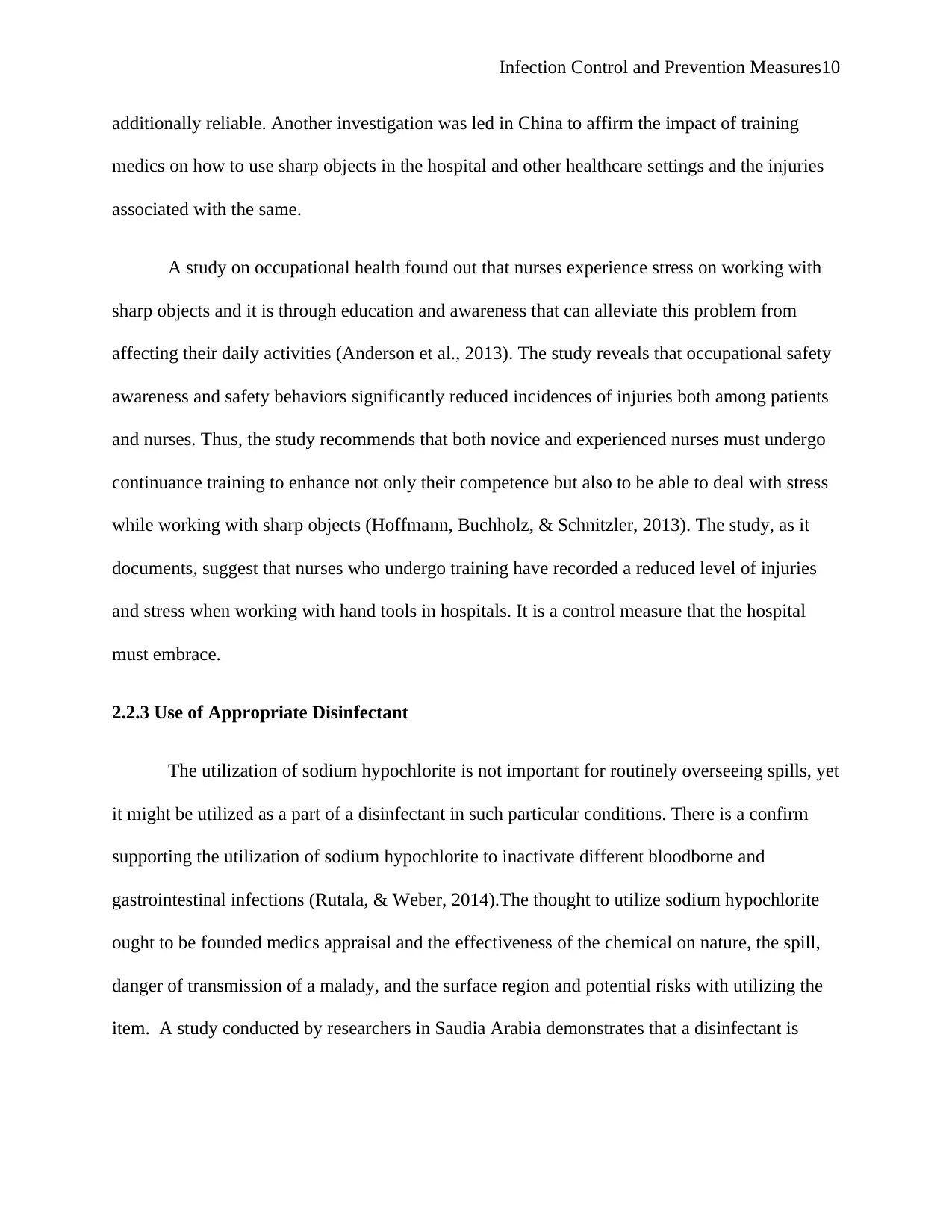
Infection Control and Prevention Measures10
additionally reliable. Another investigation was led in China to affirm the impact of training
medics on how to use sharp objects in the hospital and other healthcare settings and the injuries
associated with the same.
A study on occupational health found out that nurses experience stress on working with
sharp objects and it is through education and awareness that can alleviate this problem from
affecting their daily activities (Anderson et al., 2013). The study reveals that occupational safety
awareness and safety behaviors significantly reduced incidences of injuries both among patients
and nurses. Thus, the study recommends that both novice and experienced nurses must undergo
continuance training to enhance not only their competence but also to be able to deal with stress
while working with sharp objects (Hoffmann, Buchholz, & Schnitzler, 2013). The study, as it
documents, suggest that nurses who undergo training have recorded a reduced level of injuries
and stress when working with hand tools in hospitals. It is a control measure that the hospital
must embrace.
2.2.3 Use of Appropriate Disinfectant
The utilization of sodium hypochlorite is not important for routinely overseeing spills, yet
it might be utilized as a part of a disinfectant in such particular conditions. There is a confirm
supporting the utilization of sodium hypochlorite to inactivate different bloodborne and
gastrointestinal infections (Rutala, & Weber, 2014).The thought to utilize sodium hypochlorite
ought to be founded medics appraisal and the effectiveness of the chemical on nature, the spill,
danger of transmission of a malady, and the surface region and potential risks with utilizing the
item. A study conducted by researchers in Saudia Arabia demonstrates that a disinfectant is
additionally reliable. Another investigation was led in China to affirm the impact of training
medics on how to use sharp objects in the hospital and other healthcare settings and the injuries
associated with the same.
A study on occupational health found out that nurses experience stress on working with
sharp objects and it is through education and awareness that can alleviate this problem from
affecting their daily activities (Anderson et al., 2013). The study reveals that occupational safety
awareness and safety behaviors significantly reduced incidences of injuries both among patients
and nurses. Thus, the study recommends that both novice and experienced nurses must undergo
continuance training to enhance not only their competence but also to be able to deal with stress
while working with sharp objects (Hoffmann, Buchholz, & Schnitzler, 2013). The study, as it
documents, suggest that nurses who undergo training have recorded a reduced level of injuries
and stress when working with hand tools in hospitals. It is a control measure that the hospital
must embrace.
2.2.3 Use of Appropriate Disinfectant
The utilization of sodium hypochlorite is not important for routinely overseeing spills, yet
it might be utilized as a part of a disinfectant in such particular conditions. There is a confirm
supporting the utilization of sodium hypochlorite to inactivate different bloodborne and
gastrointestinal infections (Rutala, & Weber, 2014).The thought to utilize sodium hypochlorite
ought to be founded medics appraisal and the effectiveness of the chemical on nature, the spill,
danger of transmission of a malady, and the surface region and potential risks with utilizing the
item. A study conducted by researchers in Saudia Arabia demonstrates that a disinfectant is
Paraphrase This Document
Need a fresh take? Get an instant paraphrase of this document with our AI Paraphraser
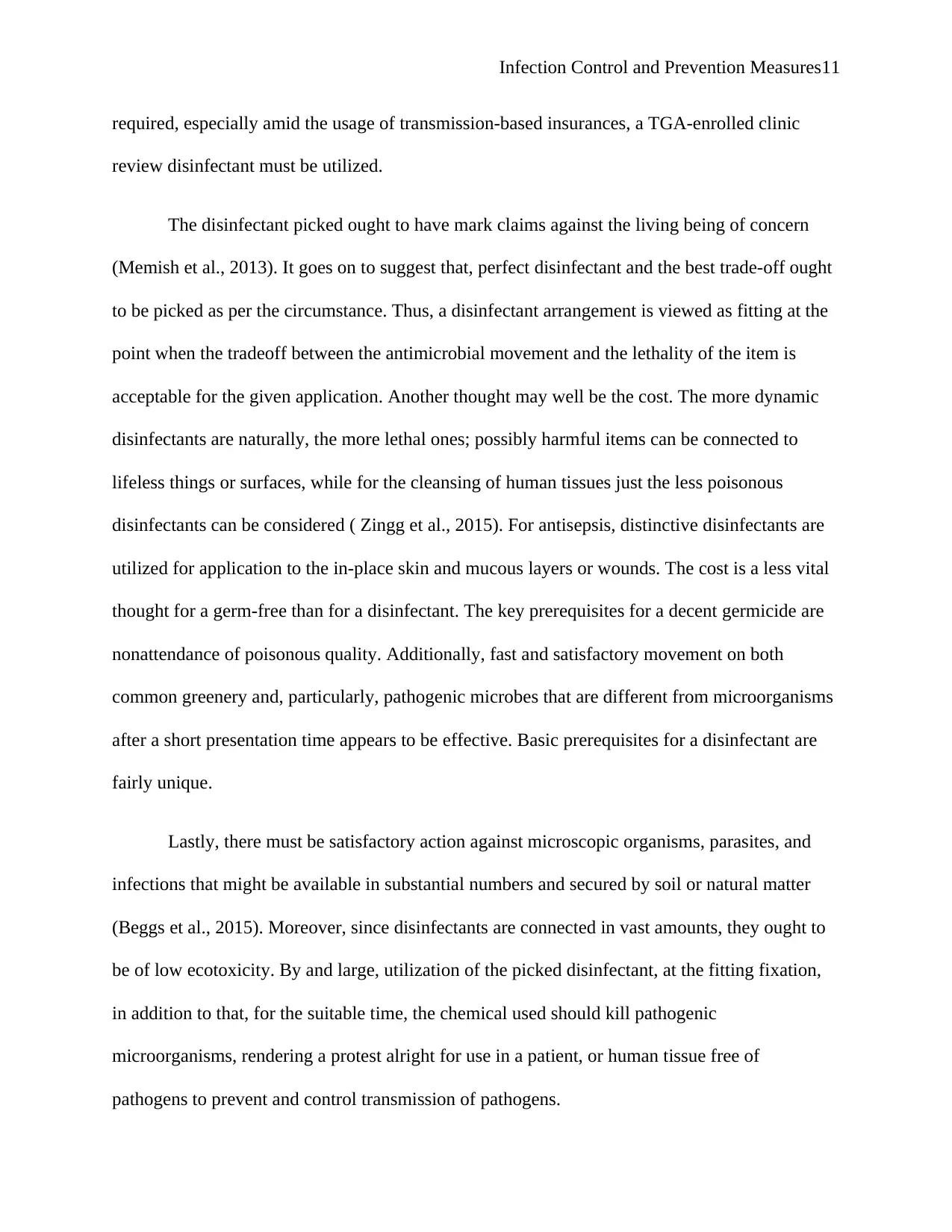
Infection Control and Prevention Measures11
required, especially amid the usage of transmission-based insurances, a TGA-enrolled clinic
review disinfectant must be utilized.
The disinfectant picked ought to have mark claims against the living being of concern
(Memish et al., 2013). It goes on to suggest that, perfect disinfectant and the best trade-off ought
to be picked as per the circumstance. Thus, a disinfectant arrangement is viewed as fitting at the
point when the tradeoff between the antimicrobial movement and the lethality of the item is
acceptable for the given application. Another thought may well be the cost. The more dynamic
disinfectants are naturally, the more lethal ones; possibly harmful items can be connected to
lifeless things or surfaces, while for the cleansing of human tissues just the less poisonous
disinfectants can be considered ( Zingg et al., 2015). For antisepsis, distinctive disinfectants are
utilized for application to the in-place skin and mucous layers or wounds. The cost is a less vital
thought for a germ-free than for a disinfectant. The key prerequisites for a decent germicide are
nonattendance of poisonous quality. Additionally, fast and satisfactory movement on both
common greenery and, particularly, pathogenic microbes that are different from microorganisms
after a short presentation time appears to be effective. Basic prerequisites for a disinfectant are
fairly unique.
Lastly, there must be satisfactory action against microscopic organisms, parasites, and
infections that might be available in substantial numbers and secured by soil or natural matter
(Beggs et al., 2015). Moreover, since disinfectants are connected in vast amounts, they ought to
be of low ecotoxicity. By and large, utilization of the picked disinfectant, at the fitting fixation,
in addition to that, for the suitable time, the chemical used should kill pathogenic
microorganisms, rendering a protest alright for use in a patient, or human tissue free of
pathogens to prevent and control transmission of pathogens.
required, especially amid the usage of transmission-based insurances, a TGA-enrolled clinic
review disinfectant must be utilized.
The disinfectant picked ought to have mark claims against the living being of concern
(Memish et al., 2013). It goes on to suggest that, perfect disinfectant and the best trade-off ought
to be picked as per the circumstance. Thus, a disinfectant arrangement is viewed as fitting at the
point when the tradeoff between the antimicrobial movement and the lethality of the item is
acceptable for the given application. Another thought may well be the cost. The more dynamic
disinfectants are naturally, the more lethal ones; possibly harmful items can be connected to
lifeless things or surfaces, while for the cleansing of human tissues just the less poisonous
disinfectants can be considered ( Zingg et al., 2015). For antisepsis, distinctive disinfectants are
utilized for application to the in-place skin and mucous layers or wounds. The cost is a less vital
thought for a germ-free than for a disinfectant. The key prerequisites for a decent germicide are
nonattendance of poisonous quality. Additionally, fast and satisfactory movement on both
common greenery and, particularly, pathogenic microbes that are different from microorganisms
after a short presentation time appears to be effective. Basic prerequisites for a disinfectant are
fairly unique.
Lastly, there must be satisfactory action against microscopic organisms, parasites, and
infections that might be available in substantial numbers and secured by soil or natural matter
(Beggs et al., 2015). Moreover, since disinfectants are connected in vast amounts, they ought to
be of low ecotoxicity. By and large, utilization of the picked disinfectant, at the fitting fixation,
in addition to that, for the suitable time, the chemical used should kill pathogenic
microorganisms, rendering a protest alright for use in a patient, or human tissue free of
pathogens to prevent and control transmission of pathogens.
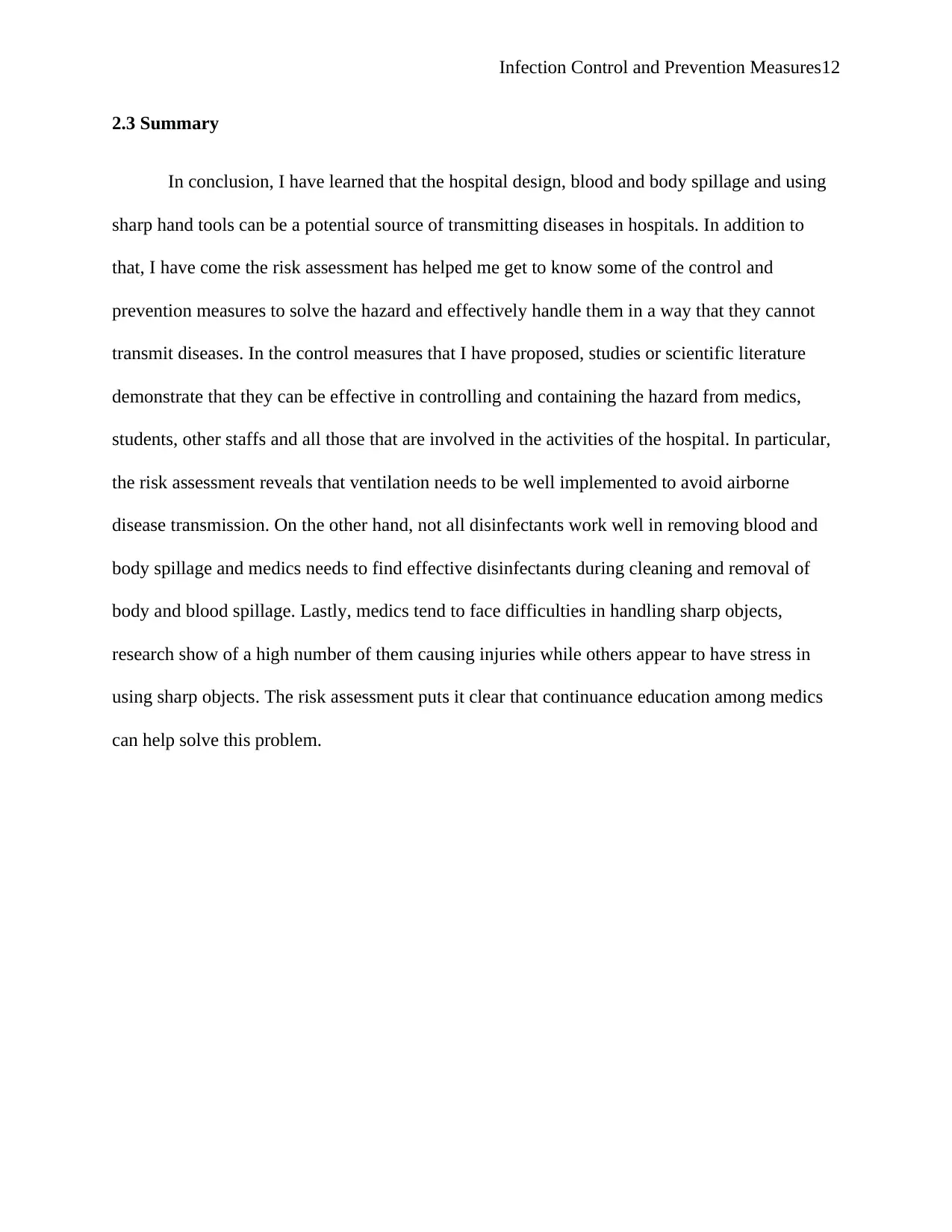
Infection Control and Prevention Measures12
2.3 Summary
In conclusion, I have learned that the hospital design, blood and body spillage and using
sharp hand tools can be a potential source of transmitting diseases in hospitals. In addition to
that, I have come the risk assessment has helped me get to know some of the control and
prevention measures to solve the hazard and effectively handle them in a way that they cannot
transmit diseases. In the control measures that I have proposed, studies or scientific literature
demonstrate that they can be effective in controlling and containing the hazard from medics,
students, other staffs and all those that are involved in the activities of the hospital. In particular,
the risk assessment reveals that ventilation needs to be well implemented to avoid airborne
disease transmission. On the other hand, not all disinfectants work well in removing blood and
body spillage and medics needs to find effective disinfectants during cleaning and removal of
body and blood spillage. Lastly, medics tend to face difficulties in handling sharp objects,
research show of a high number of them causing injuries while others appear to have stress in
using sharp objects. The risk assessment puts it clear that continuance education among medics
can help solve this problem.
2.3 Summary
In conclusion, I have learned that the hospital design, blood and body spillage and using
sharp hand tools can be a potential source of transmitting diseases in hospitals. In addition to
that, I have come the risk assessment has helped me get to know some of the control and
prevention measures to solve the hazard and effectively handle them in a way that they cannot
transmit diseases. In the control measures that I have proposed, studies or scientific literature
demonstrate that they can be effective in controlling and containing the hazard from medics,
students, other staffs and all those that are involved in the activities of the hospital. In particular,
the risk assessment reveals that ventilation needs to be well implemented to avoid airborne
disease transmission. On the other hand, not all disinfectants work well in removing blood and
body spillage and medics needs to find effective disinfectants during cleaning and removal of
body and blood spillage. Lastly, medics tend to face difficulties in handling sharp objects,
research show of a high number of them causing injuries while others appear to have stress in
using sharp objects. The risk assessment puts it clear that continuance education among medics
can help solve this problem.
⊘ This is a preview!⊘
Do you want full access?
Subscribe today to unlock all pages.

Trusted by 1+ million students worldwide
1 out of 15
Related Documents
Your All-in-One AI-Powered Toolkit for Academic Success.
+13062052269
info@desklib.com
Available 24*7 on WhatsApp / Email
![[object Object]](/_next/static/media/star-bottom.7253800d.svg)
Unlock your academic potential
Copyright © 2020–2025 A2Z Services. All Rights Reserved. Developed and managed by ZUCOL.





